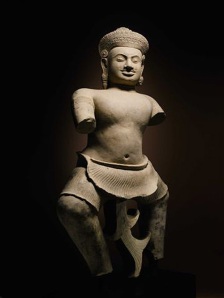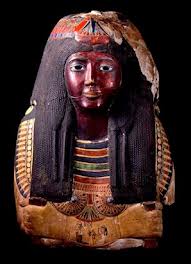The legal dispute over an ancient Khmer statue at Sotheby’s could have lasting implications for the sale of ancient art in the United States.
 For those catching up on the case: Sotheby’s New York was poised to put the 10th century temple warrior up for auction in 2010 with an estimated value of $3 million. But shortly before the bidding started, Cambodia claimed the statue had been looted from the ruins of a Khmer temple at Koh Ker, where the statue’s feet were found in 2007. In April, federal agents sought to seize the statue on behalf of Cambodia. A judge ordered the statue to remain at Sothebys while the two parties argue the case in court. Sotheby’s filed a motion to dismiss in June and now the government has responded, attaching declarations from two legal experts to support its case. (See below for the complete filings.)
For those catching up on the case: Sotheby’s New York was poised to put the 10th century temple warrior up for auction in 2010 with an estimated value of $3 million. But shortly before the bidding started, Cambodia claimed the statue had been looted from the ruins of a Khmer temple at Koh Ker, where the statue’s feet were found in 2007. In April, federal agents sought to seize the statue on behalf of Cambodia. A judge ordered the statue to remain at Sothebys while the two parties argue the case in court. Sotheby’s filed a motion to dismiss in June and now the government has responded, attaching declarations from two legal experts to support its case. (See below for the complete filings.)
At the heart of the case are familiar questions: What level of evidence is needed to establish when and how an object was illicitly removed from its borders? What amount of due diligence must a museum, collector or auction house conduct to defend an acquisition? When can a looted object in the US be seized by the government and returned to its legal owner? And can those who possess and trade looted antiquities be found criminally liable?

The feet of two ancient sandstone statues were left behind by looters at a temple in Koh Ker, Cambodia. One statue is now at Sotheby’s, the other at the Norton Simon Museum in Pasadena.
These questions have only occasionally been brought before federal courts in the United States, so the case law in this area is relatively thin. A handful of key cases have established the current legal regime, which holds that an object looted from a country with an enforced patrimony law can be considered stolen property under US law. Someone who knowingly buys or possesses a looted antiquity can be criminally charged, and the object can be taken by the government and returned to its rightful owner.
This legal regime has not prevented museums from buying suspect objects, but it has been an invaluable deterrent to the open sale of loot and helped raise the bar on acquisition standards in recent years. Given its shaky foundation, however, any new case law on these issues could alter the status quo significantly. A victory for the government in the Cambodia case might lead to a further tightening of the rules around acquisitions and bring about more cautious collecting practices for collectors and museums. A victory for Sotheby’s, on the other hand, could encourage more brazen acquisitions of looted art.
 The point is illustrated in the case filings themselves. Until recently, the leading case on the civil forfeiture of ancient art was Steinhardt, which established among other things that false declarations on import documents could allow the government to seize an object under civil law. But the recent dispute over a mummy mask at the St. Louis Museum of Art appears to have undermined the authority of that ruling, which is cited neither by the government nor Sotheby’s in the Cambodia case. Instead, both sides refer to the St. Louis case, US vs. Mask of Ka Nefer Nefer, in which the judge has found twice that the government presented insufficient evidence that the mask was stolen.
The point is illustrated in the case filings themselves. Until recently, the leading case on the civil forfeiture of ancient art was Steinhardt, which established among other things that false declarations on import documents could allow the government to seize an object under civil law. But the recent dispute over a mummy mask at the St. Louis Museum of Art appears to have undermined the authority of that ruling, which is cited neither by the government nor Sotheby’s in the Cambodia case. Instead, both sides refer to the St. Louis case, US vs. Mask of Ka Nefer Nefer, in which the judge has found twice that the government presented insufficient evidence that the mask was stolen.
Here’s how Sotheby’s quotes the judge in that case: “[t]he Government cannot simply rest on its laurels and believe that it can initiate a civil forfeiture proceeding on the basis of one bold assertion that because something went missing from one party in 1973 and turned up with another party in 1998, it was therefore stolen and/or imported or exported illegally.”
The Cambodia case, however it is decided, will be cited in similar cases going forward. With that much at stake, the court filings are worth reading — even for those of us who are not lawyers. In the past, we’ve posted the government’s original complaint here, and the flurry of filings over the statue’s seizure here.
In June, Sotheby’s filed its first significant response to the case in a motion to dismiss:
Last week the federal attorneys in Manhattan replied with their opposition to Sotheby’s move to dismiss the case:
To support their arguments, the government filed two declarations:
Caveat and Hat-tip: We’re not lawyers and don’t even play one on TV. For insightful observations about these issues from a legal expert in this area, read Rick St. Hilaire’s indispensable blog: http://culturalheritagelawyer.blogspot.com/


Hmm, this can have pretty big consequences, will definitely follow this …
Pingback: Cambodia’s Looting Crisis | SEAArch - The Southeast Asian Archaeology Newsblog
Pingback: The Guardian and the Goddess: Looted Statues Reveal Workings of Illicit Trade | CHASING APHRODITE
Pingback: Gloves Come Off: Amid Accusations of Deceit, Sotheby’s Lawsuit Reveals How U.S. Built Its Case | CHASING APHRODITE
Pingback: Repatriation of cultural property in the news | Bruno Claessens